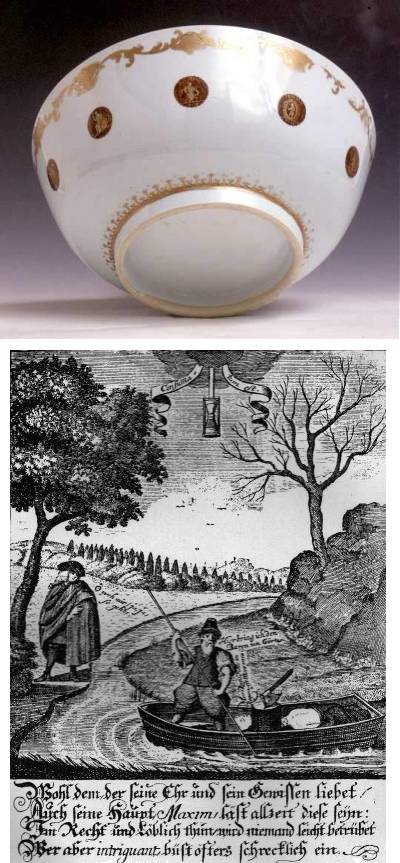
This page is only one of many thousands of Gotheborg.com Help and Information Pages, offering specialized knowledge on Chinese and Japanese Porcelain, including a Glossary, Q&A, Chinese and Japanese Porcelain Marks, Chinese Porcelain Exhibition and Excavation reports etc. For personal help and far more information, join our Discussion Board or use 'Ask a Question' for quick email consultations. For full text and better navigation, use a full-screen device rather than a mobile phone, that offers only limited content.

In February the 19th, 1719 Georg Heinrich von Görtz (1668-1719) was beheaded.
Already the 2nd of December 1718, two days after the death of King Charles the XII, Baron Görtz had been arrested in the parsonage of Tanum in Bohuslän, north of Gothenburg, and brought to Stockholm. A trip that took two weeks.
In the contemporary copper stitch to the right, by D. Fassman. Gespräche in dem Reiche der Todten, 1719 (detail), the body - and head - of Baron Görtz is brought to the "other side" in a boat.
Baron Görtz had been the late King Charles the XII's Minister of Finance and had made himself utterly unpopular by being the one who for 18 years by all available means had financed the Swedish defense war against practically all European powers during the Great Northern War - and the Tsar of Russia after the Kings disastrous invasion of Russia (1707-09). A war that eventually led to the complete collapse of the Swedish armies and the loss of Sweden's status as a great power.
One of the measures Baron Görtz had taken was to mint emergency copper coins who was to be replaced by real currency "as soon as possibly".
Interestingly enough one of the means Baron Görtz and King Charles the XII was seriously considering - to be able to put solid gold behind these copper coins - was to naturalize a hoard of pirates from Madagascar who had come to Bohuslän to offer a whole fleet of armed, manned and fully laden ships to the Kingdom of Sweden, in exchange for citizenship and protection. One of the plans considered was also to establish a Swedish colony at Madagascar, and with the Pirate's ships and money bring forward a Swedish East India Company.
Unfortunately this interesting business proposition went to naught because of the King Charles the XII's premature death, being shot with a lead button at the Fredriksten fortress in Norway in November 30, 1718.
Many of King Charles the XII's soldiers found a new employer as captains and sailors in the Swedish East India Company when it finally came to be founded in Gothenburg in 1731, without the pirates. This we don't really know of course, since the book keeping of the company was destroyed after auditing every year ...
Exactly by whom this bowl came to be ordered may be uncertain, but all the " - if only - " that must have been uttered around it while emptying its content of hot punch are all the more certain.
The decoration is in Rococo style "scroll and shell"-border in sepia, gilt and enamels.
Sincerely
Jan-Erik Nilsson
Some further reading: In China for the West, David Howard & John Ayers illustrates a similar bowl on page 238. A bowl with this decoration also occurs in Suzanne S. Mottahed, Numismatic sources of Chinese Export Porcelain decoration, The Connoisseur 1969.